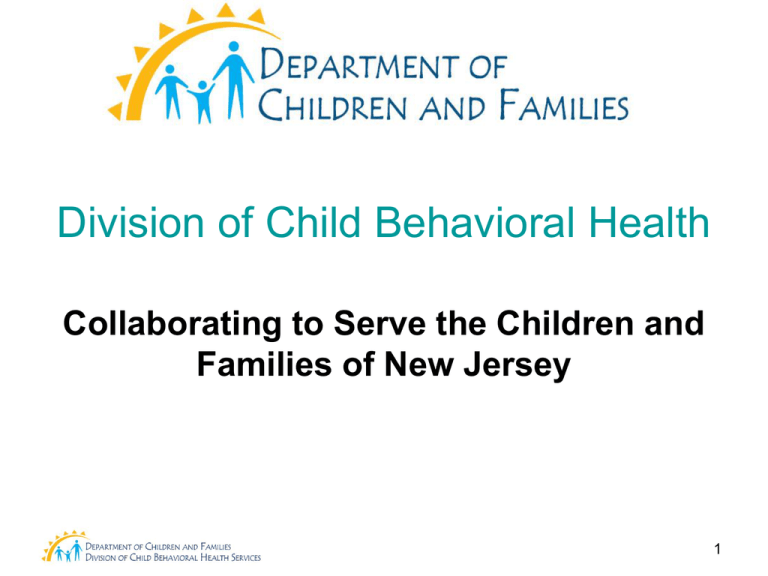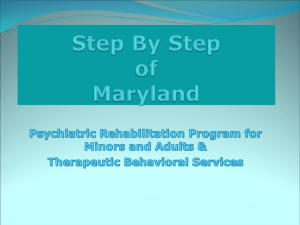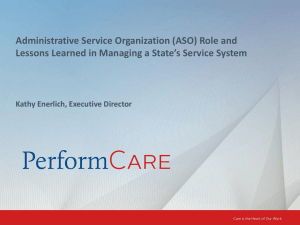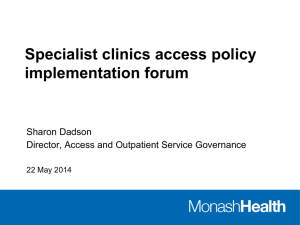REQUEST FOR PROPOSALS FOR New Jersey Task Force on Child
advertisement

Division of Child Behavioral Health Collaborating to Serve the Children and Families of New Jersey 1 DCBHS Court Liaisons Kim Maloney Liaison to Detention and Juvenile Justice (609) 888-7193 kim.maloney@dcf.state.nj.us Mike Higginbotham, MSW, LCSW Liaison to the Judiciary, Trial Courts (609) 888-7198 michael.higginbotham@dcf.state.nj.us 2 NJ Department of Children and Families New Jersey Department of Children and Families Commissioner Division of Child Behavioral Health Services Division of Youth and Family Services Division of Prevention & Community Partnerships Office of Adolescent Services Child Welfare Training Academy 3 System of Care Values and Principles Accessible Unconditional Care Accountable Team Based Collaborative VALUES: Strengths Based Promoting Independence Comprehensive Child Centered & Family Driven Cost Effective Community Based Culturally Competent Outcome Based Family Involvement Flexible Needs Driven Individualized Home, School & Community Based DCBHS Overview and Data Presentation.pptxDRAFT - Jan 3 2011 4 DCBHS Objectives We want to keep kids… At Home (with their families and not in out-of-home treatment settings) In School (in their regular school in their school district) Out of Trouble (not involved with the Juvenile Justice System or at risk of detention or incarceration) 5 The Role of Assessment within DCBHS The vision of DCBHS is to create positive outcomes for children with emotional and behavioral needs by: • Identifying the child and family’s needs • Determining the most appropriate Intensity of Service • Delivering the most appropriate services for the most appropriate length of time • Using standard assessment tools – the foundation of DCBHS’ System of Care. Positive Outcomes Appropriate Length of Stay Appropriate Services Appropriate Intensity of Service Child and Family Needs Assessment Tools 6 Mission Serve youth with emotional and/or behavioral needs and their families through strength-based, individualized, and efficacious services. Key Components CSA Single portal for access to care CMO Intensive care management utilizing a Wraparound model of care serving youth with complex needs & their families YCM Linkage for youth with moderate needs, assist youth discharged from CCISs, complete 14-day plans FSO Family-led support for CMO & UCM involved families, community education, warm lines, advocacy MRSS Crisis planning for youth with behavioral/emotional needs, available 24/7/365 7 In-Community Services Our in-community services are flexible therapy services that are provided at the home or other in-community sites to youth involved with YCM or CMO/UCM. IIC Intensive In-Community Services – Psychotherapy services provided in the youth’s home. BA Behavioral Assistance – Under a plan developed by an IIC therapist, the BA will work to modify specific behaviors of the youth. 8 The 14-day Plan 9 Juvenile Justice Access to the SOC A youth appears before the court who is believed to have behavioral healthcare needs The Judge Orders a DCF 14-day Plan The DYFS Court Liaison receives and reviews the court order 14-day Plan Process Begins Fourteen Day Plan Process Detail 14 day plan to be developed by DYFS 1. Youth has abuse, neglect or permanency Issues? 2. Youth has a currently open DYFS case? 3. Youth has one and/or two above and behavioral healthcare needs? 4. Youth has behavioral healthcare needs only? 14 day plan to be developed by Youth Case Management continued 10 Juvenile Justice Access to the SOC Youth Case Management 14-day Plan Process Flow Chart The DYFS Court Liaison refers youth to Youth Case Management continued The Youth Case Management Supervisor reviews the referral and assigns the youth to a Youth Case Manager 1. The YCM contacts PerformCare (Contracted System Administrator) at 877-652-7624 to register the youth in the CYBER system. 2. The YCM ensures that the CSA: a. b. c. d. e. Registers the youth in the CYBER system; Checks the youth’s eligibility for services; Checks to see if the youth has a preexisting CYBER record; Provides the YCM with electronic access to the youth’s CYBER record; Authorizes a minimum of days of behavioral healthcare services for the youth. The Youth Case Manager (YCM) conducts the following activities 3. The YCM completes the Medicaid Presumptive Eligibility (PE) process. 4. The YCM completes the Strengths & Needs Assessment. 5. The YCM arranges for the services the youth needs. 6. The YCM completes the 14-Day Plan Report. If at any time during the process of completing the 14 Day Plan, the youth’s family refuses to cooperate, the Youth Case Manager must notify the Court immediately and continue planning. continued 11 Juvenile Justice Access to the SOC 14-Day Plan Submission Process The Youth Case Manager (YCM) or DYFS completes the 14-Day Plan Report The 14-Day Plan Report is received by Public Defender or youth’s attorney in writing from the YCM or DYFS. IS YOUTH ADJUDICATED? No Attorney determines whether to release the plan to the Judge Yes Plan is released to the Judge The Judge: 1. Accepts the plan, or 2. Orders additional services that may include out-of-home treatment YCM, DYFS or other appropriate entity carries out the courtordered plan. 12 BioPyschoSocial (BPS) Evaluation • Resource for Juvenile Detention Centers, if case management (YCM or CMO) is not involved. • Provides recommendations for youth suspected of having mental health issues and / or score a ‘warning’ on the MAYSII. 13 Out-of-Home Treatment 14 Principles of Out of Home Treatment Family commitment to ongoing active involvement Child Family Team Clinically Based Community based first Short term In State 15 Referring a Youth to OOH Treatment To refer a youth to OOH Treatment: 1 2 3 The youth’s Family Team must have determined that a referral to OOH treatment is warranted Care Managers have no legal authority to start OOH referral process without parental permission or court order. The referral paperwork must be compiled: Referral Summary for OOH Treatment Referral Packet 16 Residential Referral Packet • Cover letter with identifying information including: Youth’s name/CYBER# Youth’s current location Date of OOH Referral request/Telephonic Review Current Intensity of Service (IOS) DYFS Involvement Efforts to secure OOH Treatment E-mail and phone # of both case manager and supervisor Supervisor’s Signature confirming review of packet • Thorough Out of Home Referral Summary (must be updated each time an OOH referral is initiated) OUT OF HOME REFERRAL PACKET CHECKLIST located at: http://www.state.nj.us/dcf/behavioral/providers/ReferralPacket.pdf 17 Residential Referral Packet Do not send incomplete packets to PerformCare Thorough Out of Home Referral Summary • Recent Clinical Information (Within six months; if within one year, include updated report(s) from therapist): Bio-psychosocial or Psychological Evaluation Psychiatric (if on medication and/or recent hospitalization) • Specialized Evaluations, if applicable (within the last year): Fire Setting Evaluation with Risk Level Psychosexual Evaluation with Risk Level Substance Abuse Evaluation • Previous Out of Home Outcomes Discharge Summaries or Rejection Documentation from prior or current Out of Home Treatment Setting Transitional Joint Care Review • Court Involvement Status and Copy of legal charges Probation reports Pre-sentencing report Court order for residential treatment • Other reports Status of DDD involvement, if applicable School-IEP, if classified Medical Reports (if child has a medical condition) 18 Out-of-Home Treatment Intensity of Service: levels of OOH treatment based on intensity, frequency, and duration of treatment: • • • • • • • CCIS – Inpatient Treatment Intensive Residential Treatment Services Psych Community Residences Specialty Beds Residential Treatment Centers Group Homes Treatment Homes 19 Out-of-Home Treatment Treatment Home • This IOS is for children/youth requiring Out of Home treatment with minimal clinical care. The child/youth is placed in the safe environment of a private home setting in which treating parents have received specialized training in the care of children/youth with emotional and behavioral challenges. • Treatment parents receive supervision and are supported by the staff and programs of the treatment home agency. • The goal of a Treatment Home is to maintain the child/youth in the community while preparing for transition: return to family of origin, adoption, permanency placement, kinship care, or independent living. 20 Out-of-Home Treatment Treatment Home Service Delivery • TH parents reside in the home with youth. • Youth attend school in the community. • The Agency provides up to one hour a week of individual counseling and up to four hours a week case management. • Medication monitoring as needed. • Youth can access additional therapeutic supports from the community, if needed. 21 Out-of-Home Treatment Group Home • A Group Home is a community-based IOS designed for youth with behavioral and emotional challenges and needs who have the capability to engage in the community. • Comprehensive services include individual, group, and family therapy, rehabilitation, and skill building. Programs are staffed around the clock. Residents go into the community for school and outside activities. • Interventions are directly related to established goals and objectives with the aim of transitioning to a lower intensity of service or home. • Family/guardian/caregiver involvement is extremely important and, unless contraindicated, should occur on a regular basis as determined in the treatment plan. 22 Out-of-Home Treatment Residential Treatment Center • Residential Treatment provides a 24-hour service for youth who have demonstrated severe and persistent needs in social, emotional, behavioral, and/or psychiatric functioning. . • RTC’s provide clinical treatment, psychiatric consultation, and medication monitoring, coupled with social, psychosocial, educational, and rehabilitative services. These are delivered through a highly structured therapeutic programming in a safe, controlled environment with a high degree of supervision. • Residential Treatment is provided in freestanding, nonhospital settings on campuses or in the community. • Some RTC programs have on-ground school services, which may require youth to be educationally classified. 23 Out-of-Home Treatment Specialty Bed Program (SPEC) • A Specialty Service Residential Program (SPEC) provides supervised, licensed, 24-hour care within an intensive treatment program for youth with significant emotional and/or behavioral psychopathology which is specifically correlated with significant life events that have impacted their personal development and progress. • The individual focus should implement therapeutic principles which are directly focused on the etiology of each individual youth’s psychopathology. Examples of therapeutic modalities which may be used include Functional Family Therapy, Cognitive Behavioral Therapy, the Sanctuary Model, and Trauma Affect Regulation. 24 Out-of-Home Treatment SPEC Criteria • Significant Trauma Indicators: History of multiple placements, substantiated history of physical, sexual, or emotional abuse and/or substantiated history of moderate to severe neglect. • Fire Setting: Within the past two years; low, moderate, and high risk with fire setting evaluation; • Assault: Within the last two years; with or without a weapon and causing injury; history of repetitive assaults; • Sexually Reactive Behavior: Within the last two years; low, moderate, or high risk with psychosexual evaluation; predatory or non-predatory; adjudicated or non-adjudicated; Tier I or II Megan’s Law. 25 Out-of-Home Treatment Specialty Bed (SPEC) Treatment in a Specialty program should include regular and ongoing family involvement, when clinically appropriate. When there is no active family, the DCF case management entities should act as (or develop) a surrogate family and be responsible for their participation in treatment meetings. The individual focus should implement therapeutic principles which are directly focused on the etiology of each individual youth’s psychopathology. Examples of therapeutic modalities which may be used include Functional Family Therapy, Cognitive Behavioral Therapy, the Sanctuary Model, and Trauma Affect Regulation. 26 Out-of-Home Treatment Psychiatric Community Homes (PCH) • Psychiatric Community Homes (PCH) are designed to provide community based treatment to youth whose DSM IV diagnosis indicates that they are in need of acute care. There are programs that serve youth from 520 years old, who may have been receiving inpatient Children’s Crisis Intervention Services (CCIS) or Intensive Residential Treatment Services (IRTS), and require ongoing psychiatric care in a safe, highly staffed, and supportive residential milieu before they can return home or transitioning to a less intensive out of home treatment setting. • These services may also be accessed by youth as a deterrent to psychiatric hospitals. 27 Special Needs Homes DD/MI - Treatment home settings, with additional supports, for youth with both clinical needs and lower intellectual functioning. Diabetes Homes – Therapeutic settings that accept youth with a diabetic condition. Pregnancy Homes (SRTU Access) Detention Alternative Program (DAP) - For youth in detention awaiting therapeutic out of home treatment. Priority population: post dispositional youth in DYFS custody. Accessed through DCBHS – gatekeeper Jennifer Holder at Jennifer.Holder@dcf.state.nj.us or 609-888-7198. • Klemmer – nine male beds • NJ Mentor – five male/female beds • Project Chance – four male/female beds 28 Referring a Youth to OOH Treatment Once Intensity of Service (IOS) is determined: 1 The CYBER electronic system automatically posts the child on Youth Link. 2 Interested providers “assign” youth to their programs 3 Care Manager (CM) monitors assignments in CYBER and contacts potential provider(s) if necessary to advocate for assignment of youth 4 CM contacts the facility(ies) and sends packets to programs assigned to the youth. 29 Referral Process Once a youth has been assigned to a program, the Care Management Entity (CME) is responsible to: OVERNIGHT the referral packet to the provider 1 2 **Packet must arrive at the provider within 72 hours of their accepting the referral Call provider to follow up and clarify youth’s needs 30 Referral Process Once a youth has been assigned to a program, the Care Management Entity is responsible to: 3 4 Provide the youth and family with all available information about the program the youth has been assigned to or facilities or providers that have expressed interest. Provide families with enough information to make an informed decision about which referral(s) to pursue. 31 Referral Process Once a youth has been assigned to a program, the CM is responsible to: 5 6 Schedule a “Meet & Greet” with youth and family’s preferred provider. CM contacts all facilities where a packet has been sent: to encourage them to accept the youth, to clarify any additional information needed, for decisions and timelines. 32 DCBHS Specialized Residential Treatment Unit (SRTU) CRITERIA FOR REFERRAL TO DCBHS SPECIALIZED RESIDENTIAL TREATMENT UNIT • A youth who has been assigned a SPEC (Specialty) Intensity of Service; PCR (Psychiatric Community Residence) Intensity of Service; a youth in need of a treatment program for pregnant teens; • A youth who has been on Youth Link for 30 days with lower IOS determinations and there are no prospects for acceptance into any out-ofhome treatment programs; • SRTU is not an emergency placement resource. Detailed information on accessing SRTU services are located at: http://www.state.nj.us/dcf/behavioral/providers/AccessSRTU.pdf DCBHS Specialized Residential Treatment Unit Attn: SRTU 50 East State Street, 4th Floor PO Box 717 Trenton, N.J. 08625 33 DCBHS Specialized Residential Treatment Unit PerformCare informs CM to send packet to SRTU at time of IOS determination when criteria are met. CM overnights to SRTU the required Referral Packet immediately and confirms receipt within 72-hours with Olivia Townsend at 609.888.7214. Ms. Townsend assigns the child to a SRTU consultant. The CM contacts the SRTU consultant by email. SRTU consultant informs the CM of the next steps and the CM follows through with the recommendations. It is the CM’s responsibility to initiate, update, and maintain communication with the SRTU consultant. If the child is accepted to OOH Treatment Setting, the OOH Treatment Setting contacts PerformCare to attach the provider to the youth’s referral to the provider. 34 Things that delay the referral process: Poor documentation Failure to present child in a strength based manner Missing set timelines Failure to communicate with SRTU Consultant Procrastination Incomplete Packet 35 Ways to Expedite Placement Include all requested information listed in the OOH Referral Checklist when submitting packet to PerformCare, SRTU and/or OOH providers. Ensure OOH packet contains adequate clinical information that supports requested Intensity of Service. Make certain that youth is presented in a strength-based manner. Meet all set submission timelines: • Submit OOH Referral to PerformCare as soon as possible; • Immediately send packet to SRTU when youth receives SPEC or PCH determination; • Immediately send packet to assigned providers, regardless of bed availability. Maintain e-mail communication with pending providers on a regular basis to ensure youth receives a timely meet-and-greet even when there are no current openings. Ongoing e-mail communication with SRTU Consultant, if assigned. 36 Transitional Care Present OOH treatment setting submits Transitional Joint Care Review (TJCR) with either a recommendation for a lower, higher, or same level of care. The current OOH Treatment Setting contacts a specific alternative OOH Treatment Setting to transition the child. Youth is placed on Youth Link in CYBER so providers can view the OOH referral summary. OOH treatment setting shares clinical information with prospective new placement entities and CM. CM receives & follows-up on the information from the current placement and contacts the perspective new OOH treatment setting(s). 37 Problem Solving for Court-involved Youth Issues Regarding: Contact: Case Management Entity Specific Youth System Issues • • • • Care Manager Supervisor Clinical Director Executive Director/CEO Juvenile Justice - Kim Maloney Judiciary – Mike Higginbotham 38 For more information… 1 www.nj.gov/dcf/behavioral PerformCare Member Services: 1-877-652-7624 www.performcarenj.org 39 Out-of-Home Treatment Glossary of Acronyms and Terms • • • • • • • DCBHS (Division of Child Behavioral Health Services) – The Division within DCF that provides a comprehensive approach to the provision of mental and behavioral health services to eligible children, youth, and young adults. DCF (Department of Children and Families) - The Department that includes DCBHS, DYFS, and DPCP (Division of Prevention and Community Partnerships). Youth Link – The technology in CYBER by which both case managers and OOH treatment providers manage referrals, admissions, and discharges. It is a dynamic real-time process. CSA (Contracted System Administrator - PerformCare) - An administrative organization contracted by the DCBHS to provide utilization management, care coordination, quality management, and information management for the Children’s System of Care that provides mental and/or behavioral health services and supports to eligible children, youth, and young adults. CYBER (Child Youth Behavioral Health Electronic Record) is a fully functional, multisystem electronic medical record. The protected health information (PHI) contained in CYBER is protected by HIPAA regulations and should be accessed only on a need to know basis. Please review HIPAA regulations and address any questions with your supervisor to ensure compliance. IOS (Intensity of Service) – Frequency, intensity, and duration of treatment services. SRTU - Specialized Residential Treatment Unit is a part of DCBHS. It works toward quality OOH programming and provides consultation to case managers for who have been on the Youth Link for 30+ days as well as the SPEC, PCH, and Special Needs Homes Utilization Management. 40 Thank you 41 41







